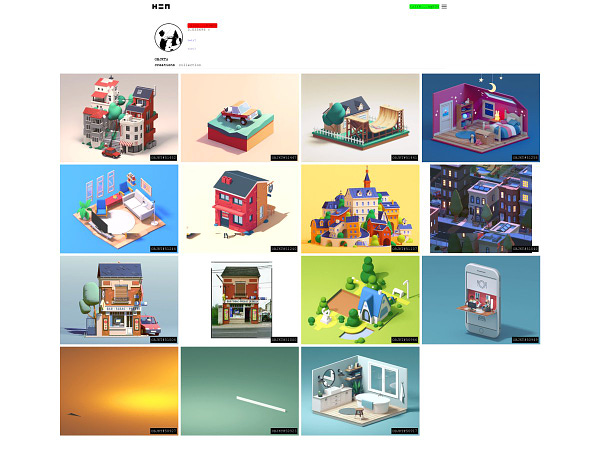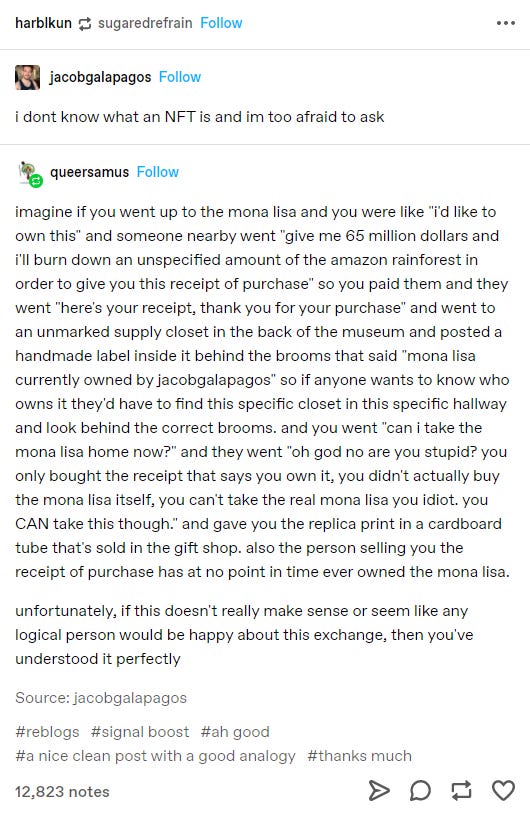In defense of NFTs: they aren't just JPEG files, and I like their innovations and promises...
Many frauds in the NFT space and it's likely a bubble. But NFTs aren't just JPEG files; there are real innovations behind. In the digital age, NFTs represent an unstoppable secular trend...
Took a break from the emails cuz’ I have 4 final exams and 2 papers before graduating next weekend, hence some delay.
I wrote about NFTs (non-fungible tokens) around two weeks ago in “I'm selling myself as an NFT…”, where my friend and digital artist Wendi Yan gave a detailed overview of NFTs and her process of minting and selling an NFT. Our punchlines back then were:
There is actually a lot of value that NFTs are contributing to the art community. Digital art used to not have any monetary value. If you weren’t in a famous animation studio, or a coder-artist working on commercial projects, or at a similar “job” – you couldn’t really earn money with your digital art. Now anyone could mint their art and sell it.
The threshold for selling your digital art has become way lower after the emergence of NFT.
Perhaps a better way to put it is: there just was nothing like NFTs before, and now there is, and that’s better than nothing.
As a follow up, today Wendi and I dig deeper into the problems in the NFT space and discuss a number of questions of hot debate: Are NFTs just JPEG files? What are the real technical and creative innovations of NFTs?
The problems of the NFT space for artists
The NFT space is definitely very chaotic today, and it’s very easy to cheat on the platforms. Copyminting is a main one. Copyminters take files made by other people and mint NFTs without the original artists knowing. The current NFT platforms have no measures in verifying the original sources of the NFTs. There is also the security issue of NFTs getting stolen. If the owner’s account gets hacked, the hacker can essentially sell the NFTs to another account, and subsequently re-selling them for much higher prices.


As time goes on, there will also be more “bad art.” It’s already evident to us that, more often than not, it’s not the art with the deepest message and most poetic presentation, or art produced by the most skilled, that earns the most.
One might even say the opposite is true: the most ridiculous and simplest ideas could earn one millions. Ridiculous things are being sold at crazy high prices –– an NFT toilet paper was sold at $300+ a few weeks ago. And take “The Pixel” as an example: with the help of Sotheby’s, the artist Pak sold a single grey pixel for $1.36 million. (So NFTs aren’t just JPEG files; they can be something much more simplistic haha).
Wendi wants to point out the following caveats about the NFT space:
The most profitable NFTs are still mainly collectibles, which are not produced by individual artists for artistic expressions. CryptoKitties, CryptoPunks, NBA highlights… ––those are not really art. We should keep in mind that the high amount some people are making out of NFTs are not through buying and reselling art, but more just collectibles.
Then, because of the high financial value and popularity of certain collectibles, some artists begin making derivative works, hoping that borrowing the fame or the perceived worth of those existing collections could significantly increase the perceived value of their own art. For example, someone minted a collection of 3D versions they made of the cryptopunks and made tens of thousands of dollars out of them. It’s very hard to say that there is any creative input to “3-dimensionalizing” an already popular NFT collection.

Overall, sensational art is favored. It’s hard to say anything about it because who are we to judge what art people should see and experience? NFTs and blockchain are all about decentralizing art and allowing individual collectors to price artworks anyways, so maybe in some sense this is just how things are supposed to be done?...
So imagine what the NFT markets will look like in a couple of months or a few years. More likely than not, the markets will be flooded with “bad art” –– art that’s not backed by strong concepts or individualized thoughts, but created to appeal on the surface-level, grab attention, and make a sensation.
Isn’t an NFT just a JPEG file? Nah…
One of the biggest criticisms against NFTs and digital art in general is that you don’t have physical ownership. “I don’t feel like I have the art.” “What’s the point of owning art if it’s just on some blockchain?!”
OK here’s the NFT <—> Mona Lisa analogy that everyone’s been waiting for (quite a funny tweet):
To play devil’s advocate, I actually don’t find this to be a big issue and would like to keep an open mind to see how things upfold.
One counter-argument to the above is: the more reproducible, the more valuable something is. The fact that Mona Lisa is on countless T-shirts, posters, and coffee mugs only makes the original more valuable. I don’t think the Louvre is fundamentally worried that Mona Lisa appears in too many places outside of their museum space.
Physical ownership matters for most people, but it also doesn’t matter for a lot of people, particularly the collectors in the digital art space. NFTs simply provide just another form of ownership, and if you’re a collector who derives pleasure in owning digital items, I would have no problem with that. This comes more down to individual preferences. So I don’t really think it’s a valid critique to say that NFTs aren’t real art just because they aren’t physical goods and cannot provide physical ownership.
Abundance vs. scarcity; distribution in the digital age
This is the rule of “abundance vs. scarcity” –– you want a physical good to be scarce to pump up its value, sure, but the game is just different in today’s hyper-digital age. The Internet already makes the distribution cost to be almost zero, and the digital space means everything is infinitely reproducible. So, what’s the point of keeping something scarce when there’s not really a way of doing so? You could own the most valuable physical artwork like Mona Lisa, but it’s still gonna be all over the Internet and flea markets anyways!
This is like the music industry –– you can’t really prevent people from downloading an MP3 file of a Taylor Swift song from some pirate site, so the business model of forcing everyone to pay $1.99 for a download just doesn’t really make sense. Spotify’s on-demand streaming service is thus brilliant.
Likewise with the streaming services. Many tech analysts and journalists like Ben Thompson have written extensively about this transformation: 20 years ago it was impossible to do whatever Netflix and Disney are doing today. We used to have the conventional setup of creators, whole-sellers, retailers... and that is because distribution was the constraint. You couldn’t distribute to everyone on Earth without the middle men. Now with the Internet they can.
We’re now in a world that distribution is no longer the constraint, and you can now go directly to consumers via the Internet, so now everyone needs to rethink their business models. Netflix first shocked everyone, and Disney is considered a great company because they quickly recognized this paradigm shift, did not just hold on to their old way of making money, and rolled out streaming services like Disney+ to meet the trend.
I don’t see how the fine arts industry isn’t going to be disrupted in some fundamental way as well. NFTs are just the beginning of a secular trend that will force auction houses and artists to rethink their distribution and business models. Sure, we might be in a bubble now in terms of valuation or whatnot, but this is a long secular trend that just seems unstoppable to me.
It’s interesting to note that the first NFT was minted in 2014, as a part of the collaboration between Anil Dash and Kevin McCoy through Seven on Seven in New York (here’s a thoughtful piece by Anil titled “NFTs Weren’t Supposed to End Like This”). Someone was actively trying to get auction houses like Sotheby’s to sell NFTs back in 2018 to no avail:

There are real innovations behind NFTs
One true technical innovation related to NFTs is that the financial infrastructure underneath can be updated in the future. NFT is a digital token in the back of the art that is connected with the DeFi (Decentralized Finance) apparatus that people can continue to innovate on.
I see a lot of promises in smart contracts, which are self-executing applications built on blockchains that put the terms of agreement between buyers and sellers directly into lines of code. The code controls the execution, and transactions are trackable and irreversible. Smart contracts for NFTs can guarantee that a fraction of future transaction revenues will always go back to the original artists, for example. These are real innovations and not just fancy narratives.
The rise of NFTs also follows this long trend we’re seeing about democratization of financial ownership. NFT allows the fractionalization of ownership, meaning that you can own like 1/100th of a piece of artwork. An artist can decide to make only a certain number of copies for a piece of digital art, say 100 copies, and by owning 1 copy you de facto own 1/100th of the art (as explained in our last email).
NFT is also like Patreon (which is at the center of the booming creator economy) but even more participatory, because now the fractional owners are not just financing or subscribing to an artist; they’re actively purchasing a small portion of the right to own the artist’s creation, and that means they now have “skin in the game” for the artist’s success.
Are NFTs a bubble? Sure but so what…
“It’s definitely a bubble now,” says everyone around me and every journalist on the Internet. But why? Based on what observations and metrics are you arriving at this conclusion? You say it’s a bubble, but why couldn’t it be the beginning of a boom or flourishment of human potential?
One argument you can make is that NFTs are not appreciating assets. They’re like collectibles and sports cars, and while some of them will continue to appreciate in value, as an asset class it’s not something like stocks that represent the evolution of businesses. NFTs are also not as liquid as cryptocurrencies, which means you can’t trade them and innovate on them as quickly as other crypto projects.
These criticisms are very valid, and Wendi and I have also written about the technical and creative challenges of the space. I foresee a major correction in NFT valuation just like with any other asset class at their initial boom, but at the end of the day I am slightly more convinced by its promises (both for the art community and the underlying technical innovations) than current drawbacks.
There are some structural issues that make NFTs a bubble right now (e.g. too much cheap capital flowing around, and too many people suddenly became rich off of cryptocurrencies and spent their crypto wealth on NFTs), but it doesn’t mean you can’t resolve these issues, and it doesn’t mean the structural factors backing up this innovation are completely BS.
We are still at an early phase of price and value discovery, so sure things are frothy, but I’m just not fundamentally concerned.
A quick word about the “metaverse” vision
A key idea associated with NFTs is the “metaverse.” When people talk about it, they could mean dramatically different things, depending on their professional background and interests. Here’s a great explanation by Wendi:
A main vision for the metaverse is a hyper-connected virtual space in which you no longer have to jump from platforms to platforms, accounts to accounts, software/app to software/app, games to games, to do the things you need and want to do on the Internet.
For someone with extensive experience and interests in media and entertainment, they may consider Roblox or Fortnite as an important precursor to the metaverse, or even the foundation for the metaverse to be developed/grown out of. There are so many players on Roblox and Fortnite, and they are using the virtual infrastructure of these gaming platforms to do way more than simply playing the game. Travis Scott hosted a concert in Fortnite last April, for example, and players could move around in the virtual environment as the concert took place.
Here are some good articles:
A good intro article that mentions Fortnite and also virtual fashion
Metaverse is too much to cover here, but certainly some version of NFTs will be directly embedded in the metaverse.
As always, please let me know your thoughts. You may leave a public comment, or privately respond to this email which will carry your words directly to my personal inbox.
If you like my emails, I would appreciate if you could tell your friends and family about it!
If you can’t find my emails in your inbox, please check your spam folder and in the “Promotions” tab for your Gmail. You may mark this email address “tigergao@substack.com” as “not spam” or “trusted sender” in your settings. Please feel free to let me know if you still have trouble receiving my emails.






